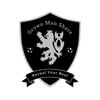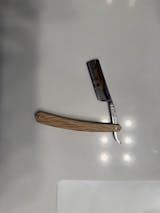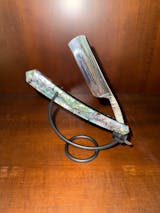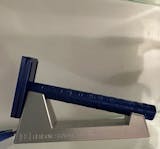Since the dawn of time man has used many tools to shave with. From stone and flint to clamshells, gold, and copper by the Egyptians, shaving has taken many forms.
In its evolution, straight razors or the cut throat razor became popular in the late 1600s. The most in demand kind were "Sheffield wares," made using highly polished steel known as "Sheffield silver steel" world-renowned for its deep high gloss finish still used today by Thiers Issard.
In our modern era, mid- 20th century preferences and styles changed and the straight edge razor was replaced by the safety razor for convenience. Today the number of wet shaving enthusiasts is making a comeback around the world and most people have become appreciative of the time honored tradition and benefits of the shaving ritual.
It's safe to say since the 17th century, no person has created perfected a more perfect shave and a more effective shaving instrument than a straight razor for your facial skin. They are your beard’s worst nightmare.
Shaving with straight razors or cut-throat razors whether they are luxurious French blades such as Thiers Issard or Precision German Steel such as Dovo or Böker is a relatively easy skill to grasp. Even for beginner's wet shaving can be effortless once you get the hang of using one, no safety razor or disposable cartridge comes even close to giving you as good a shave.

The cutting edge of straight razors has always been better for your facial skin in several areas
- Increased precision and control - Great control and the ability to reach small areas when wet shaving in comparison to other different types of wet shaving products.
- A perfectly balanced shave - Reduces the risk of getting nicks, irritation, cuts, infections, and ingrown hairs when wet shaving.
- Cost savings and environmentally friendly - Straight razors can last a lifetime when cared for properly in addition to no disposable parts or cartridges they are good for the earth.
THE BASIC ANATOMY OF A STRAIGHT RAZOR

The basic anatomy of a straight razor isn't that complicated either: Straight razors consist of two main parts including the straight razor handle and the blade Or cutting edge. However, those parts include a number of smaller sub-components and each contributes to its utility and the anatomy of a straight razor.
With a little skill and practice, you can transform a once-be chore into a ritual that gives you a few moments to focus without interruption (Just leave your phone outside the bathroom).
THE POINT
The point generally refers to where the top edge ends on the spine. Despite its name, blade points aren’t always sharpened. Look for straight razors with the following characteristics of points according to your goals and skill level.
There are 6 different types of points divided into six main groups:
- Round Point
- Square/Spike
- Barber’s notch
- Spanish Point
- French Point
- Hook Point
Round Point: The most commonly used, is the rounded point tip, which makes it easier to avoid accidental nips, but it's still sharp enough to get pesky nose and ear hair
Spike/Square: The sharpest blade tip and is best for skilled wet shavers, the square offers the most control for small areas under the earlobe, nostrils, in addition to shaping the edges of your beard.
Barber’s Notch: An indented, round-nosed blade that makes it easier to open and preferred by barber’s hence the nickname “Barber’s Notch”.
Spanish Point: A unique blade with a more subtle concave notch than the tip of the barber’s point.
French/Irish Point: A specialty blade where the point juts out from the spine at an angle to improve maneuverability around mustaches and beards.
Hook Point: A rare cut similar to a barber’s point.
BLADE MATERIAL

A good quality razor starts at the blade and the perfect shave starts and ends with the blade material. It is one of the most important elements most users pay attention to when it comes to straight razor shaving
THERE ARE THREE MAIN TYPES OF STEEL:
- Carbon steel: Can rust and needs to be properly stored but is easier to sharpen and strop and keeps a sharp edge longer.
- Stainless steel: Doesn't rust but can be a bit harder to sharpen and requires honing more often.
- Damascus steel: A distinctive looking blade akin to carbon steel unique to each artisan or manufacturer
Carbon steel is the original steel straight razors that were made back in the 19th century. The benefit is that it is very easy to strop and keep a sharp edge. This makes it a great metal for straight razors.
The downside of carbon steel is it doesn't have any protection to prevent oxidation (rust), so you need to make sure to completely dry your razor after use, store it in a cool dry place with a light coat of camellia oil or petroleum jelly to protect the blade from moisture.
The difference between carbon steel and stainless is that chrome is added to the alloy to create stainless steel. Chrome makes the atomic structure of the steel more coarse but protects it from oxidation.
Traditional Damascus Steel is forged from at least two different alloys of steel and may not be ideal for shaving. However, the razors we carry use state-of-the-art powder metallurgical Damasteel rippled together, pressed, and sintered. With this method, you receive a very fine structure of the material and a much higher share of carbide than in the traditionally made steel.
BLADE GRINDS

The blade grind is a scale of razor sharpness, ranging from long and thin to short and wedged. Each level of fineness offers its own benefits depending on their hair thickness and skin sensitivity.
To see what a grind looks like, open your straight razor and look right down the barrel of the blade. Longer thinner blades usually referred to as “hollow” offer more flexibility as you swipe across your face but take more skill to wield. Wider “wedge” blades are less flexible but more forgiving of shakier hands.
Hollow Grinds the most common variety of grinding method, hollows can still come in varying degrees from full wedge, quarter hollow to full hollow. By removing more of his face more material hollower are lighter. The most common varieties are quarter hollow, full hollow, and near wedge.
As the blade is usually thinner it is relatively flexible which means it is able to follow the contours of your skin more easily.
Hollow grinds are the most desirable however the thinner the blade, the more fragile they can be, so care needs to be taken to not drop or over sharpen, which can cause the blade to break. Sometimes hollow grindings have a belly with a slight curve, and the ridge acting as a stabilizer, across the blade. This adds support by offering greater resistance to flexing muscles. Indeed many hollow grinds have been developed by honing a nearly imperceptible belly.
Here are the main type of thinner grinds:
- Extra Hollow “Singing”
- Full Hollow and Quarter Hollow
- Half Hollow
There are two main styles for wider grinds:
- Near Wedge
- True Wedge
SPINE

The spine of the straight razor is the opposite side of the sharp edge on the blade. The spine isn’t meant for your fingers but some guys prefer to grip the blade this way.
TOE

The toe is used in determining razor blade sizes, which are measured from the toe up to the spine. There is more than one type of toe with some squared for precision and others rounded to be more gentle. The toe is usually at an angle or arc at the tip of the razor, below the blade point, and serves the same purpose as the heel. It does most of the dirty work for wet shavers for hard-to-get places.
DIFFERENT BLADE SIZES
A blade is measured from the top of the grind, right below the spine, to the cutting edge, and is measured in fractions of eighths divided into an inch. In simplistic terms, smaller blade sizes will allow you greater control for shaping and tricky maneuvers around your face such as trimming under your nose or shaping a beard. 5/8" is the most popular blade size as it's easy to handle and move around your face. It's the most common size people reach for as they are getting started with straight razor shaving. Often people will add a 6/8" to their collection for those that want a bit of a larger blade to straight razor handle. While not as common, serious collectors will add 3/8", 4/8", 7/8" and 8/8" razors to their collection.
The most popular sizes are:
- 5/8"
- 6/8"
For men with beards and facial hair and increased maneuverability:
- 3/8"
- 4/8"
For a little bit of fun:
- 7/8"
- 8/8"
HEEL

The heel is at the opposite side of the toe and represents the end of the cutting edge. It serves the same purpose as the toe and some gentlemen prefer using the heel to nab certain hard spots, but it’s not necessarily used in every shaving method. The heel varies in levels of sharpness.
CUTTING EDGE/BEVEL

The edge is the sharpest side of the blade. There are two kinds you’ll encounter in straight razor blade anatomy:
Traditional: An edge that is a straight line from toe to heel
Curved: Often referred to as a smile, it is curved to various degrees from the toe to the heel.
Curved razors are designed to slice rather than chop your curls, which can extend the life of the blade. Some guys also find honing a curved blade to be a little easier.
Its edge and point are responsible for the cutting of hair, while the rest of the part of the blade parts help in offering the perfect grip for a haircut.
SHOULDER

The shoulder is a small, gradual decline on the face of the blade that marks the end of the cutting edge and the start of where the blade is traditionally gripped (the tang).
They’re not found on every blade, though they can be helpful to beginners: the bulge of the shoulder makes it easier to determine where you should grip the razor while you’re shaving.
TANG

Also called the shank, the tang is the lower end of the blade, from the shoulder downward. The main part of the tang is located between the shoulder and the pivot and let’s you use finger power to control the razor. Using your thumb or fingers, pressure can be controlled a bit easier to create just the right balance.
TAIL

The tail is the curved end of the tang, from the pivot onward. Swiping down on the tail part of the tang with your thumb or index finger opens the blade, but can also be used while shaving to achieve your ideal shaving pressure.
JIMPS

Not all straight razors have jimps. But those who have indentations in the tang are designed for a more stable and improved grip for your thumb and index finger. They can be found on the top and bottom side of the tang where you might place your fingers. Most people who are new to straight razor shaving often have an easier time using a tang that comes with jimps.
FACE

The flat surface of the blade where brands often emboss their artwork.
SUB-COMPONENTS
In addition to the blade, the anatomy of a straight razor is also made up of two more parts:
- Scales (the handle)
- The pivot pin
SCALE MATERIALS

Another name for the straight razor handle, scales are designed to both cover and protect the cutting edge when not in use, add some counterweight, and look as handsome as can be in your hand.
In the anatomy of a straight razor, the scales are often thought of as the most beautiful part.
Plastic, resins, pearls horns, and variations of wood are the most common materials used in high-quality razors. The materials are important because they lend to the blade's balance - or how it is weighted in your hands as you shave.
Handle scales carefully...
The chances are if you drop your razor on the bathroom floor you will likely crack your scales or chip your blade. Take great care to dry off your razor and/or hands after rinsing the blade under water.
SCALES CAN BE MADE FROM MANY DIFFERENT MATERIALS
Luxurious elements used in scales include:
- Desert Ironwood
- Horn
- Bone
- Curly Birch
- Ebony
- Paua
- Mother of Pearl
- Gold (especially as inlays).
Standard options for scales come in all styles such as:
- Resin
- Carbon fiber
- Plastic
- Cow Horn
- Faux Tortoiseshell
- Olivewood
Collectors all over the world hunt down straight razors for unique scales.
Choosing between one scale and another is largely a personal choice, and custom scales or limited edition scales can also be created for discerning shavers.
PIVOT PIN

Everything discussed in the anatomy of a straight razor relies on the work of one part: the pivot pin, the point at which the spine and the tang meet, where the blade is connected to the handle.
It should allow you to open the straight razor with ease, but also be sturdy enough to give you a balanced shave. Some brands have adjustable pivots which give you greater control.
THE TWO TYPES OF STRAIGHT RAZORS
When you’re just starting off learning the anatomy of a straight razor, you’ll see that you can choose between two different types: a shavette or a traditional straight razor.
What’s the difference?
Traditional straight razor: a long blade with a variety of different types of blade sizes attached by a pivot to a handle that opens and closes.

Shavette straight razor: A traditional razor where the blade straight razor is disposable and replaceable often used as a tool by barbers for detail work.

It’s tempting to think of shavettes as "shave ready" a bridge between a safety and a straight razor, but they each provide their own type of wet shaving experience. A traditional straight razor is more balanced, but they are both sharp tools that give a great shave.
Now, let’s jump into some of the terms you should know that make up the anatomy of a straight razor.
WET SHAVING IN PRACTICE
From understanding how a straight razor is ground to where it is held and about honing, you can read product descriptions to get a better idea of what to purchase from our top-selling collection.
















